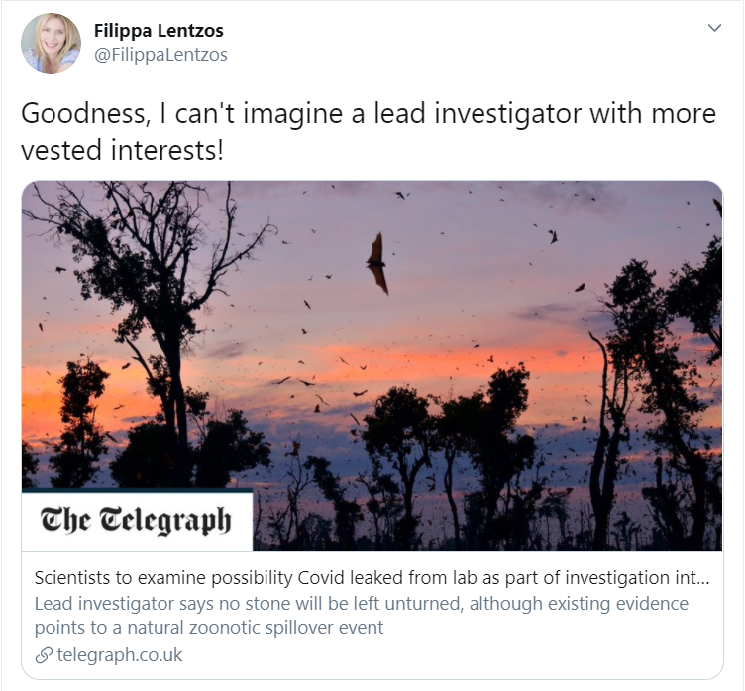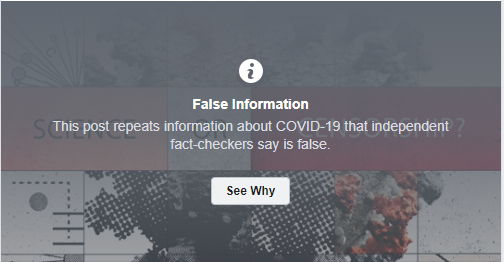
Scientists Outraged by Peter Daszak Leading Enquiry Into Possible Covid Lab Leak
Expressions of outrage and incredulity have greeted the announcement that Peter Daszak, president of EcoHealth Alliance, has been chosen to lead a Task Force that will examine the possibility that Covid-19 could have emerged from a lab, as part of an investigation into the origins of the virus.
September 23, 2020 | Source: GM Watch | by
Lead investigator is considered one of the most conflicted and unreliable voices on the issue. Jonathan Matthews reports
Expressions of outrage and incredulity have greeted the announcement that Peter Daszak, president of EcoHealth Alliance, has been chosen to lead a Task Force that will examine the possibility that Covid-19 could have emerged from a lab, as part of an investigation into the origins of the virus.
Daszak has promised to undertake the investigation “with an open mind”. But this is hard to imagine, given his previous dismissals of suggestions that SARS-CoV-2 could have leaked from a lab as “preposterous”, “baseless”, “crackpot”, “conspiracy theories” and “pure baloney”.
Misinformation super-spreader
Daszak’s investigation forms part of the work of the Lancet Covid-19 Commission – a body launched in July to look at the handling of the pandemic and “offer practical solutions”. In a statement, the Commission said it was “extremely important that the research into the origins of SARS-CoV-2 should proceed … in a scientific and objective way that is unhindered by geopolitical agendas and misinformation”.
But Daszak himself is considered a misinformation super-spreader by critics like Rutgers University microbiologist Richard Ebright, who has accused him of lying “on a Trumpian scale”, and the evolutionary theorist Bret Weinstein who has labelled him “Patient Zero for misinformation” on the origins of Covid-19.
A 100-million-dollar-plus conflict of interest
There is also the issue of conflicts of interest. Although Daszak declared in The Lancet that he has “no competing interests” on Covid-19, and likewise told the Washington Post he has “no conflicts of interest”, Alina Chan, a molecular biologist at the Broad Institute, points out that he is a “long-time friend, collaborator and funder of the Shi lab” – the Wuhan Institute of Virology (WIV) lab led by Shi Zhengli that is most often identified as the probable source of any lab leak.
In fact, Daszak’s EcoHealth Alliance has helped finance both the WIV’s bat coronavirus surveillance and its bat coronavirus gain-of-function research (research aimed at making a virus more infective), with the help of multi-million dollar grants from the US government. This, of course, means Daszak’s own activities are material to the subject he is investigating: the origins of a bat-derived coronavirus pandemic that broke out in the very city to which he helped lab workers bring bat coronaviruses for storage, analysis and experimentation.
As Richard Ebright has noted, “For persons who were directly involved in funding, promoting, and/or performing bat coronavirus research and bat coronavirus gain-of-function research at WIV, avoiding a possible finding of culpability for triggering a pandemic is a powerful motivator.” And Daszak would be at the very top of the list of those involved in funding, promoting and collaborating in that research.
More broadly, as Ebright also notes, Daszak’s EcoHealth Alliance has received over $100 million in funding from US government agencies for a variety of virus surveillance and virus gain of function work – the kind of work that could be brought into serious question if Daszak found any evidence it contributed to causing the pandemic.
How did The Lancet manage to overlook such an enormous conflict of interest, Ebright wonders, while Dr Filippa Lentzos, an expert on biological threats at King’s College London, tweeted, “Goodness. I can’t imagine a lead investigator with more vested interests!”

More misinformation
The Broad Institute’s Alina Chan drily suggests the Lancet Commission “could have also just asked the WIV to investigate themselves directly”, saving the Lancet time, money and effort. After all, Chan points out, if they thought that Daszak’s longstanding Wuhan connections – he has collaborated with Shi Zhengli’s team on coronaviruses for 15 years – meant he would be well placed to reveal what had been going on there, then they were clearly mistaken.
Chan’s comments relate to the publication by the Sunday Times of an Insight investigation into RaTG13 – the bat coronavirus said to be most closely related to SARS-COV-2. Because the Sunday Times’ journalists couldn’t get the WIV to answer any of their questions about RaTG13’s history or the lack of transparency surrounding it, they turned to Peter Daszak for answers.
They wanted to know why if RaTG13 had, as now appears, been collected in 2013 by the WIV from a mine where miners had died from an illness remarkably similar to Covid-19, it took Daszak’s long-time collaborator Shi Zhengli and her team until 2020 to publish a description of the virus. In other words, if they had known about it for 7 years, why was it suddenly produced like a rabbit out of a hat only after the SARS-CoV-2 outbreak was starting to develop into a global pandemic?
Daszak told the Sunday Times that RaTG13 had just been sitting in a WIV freezer for seven years with nobody taking any interest in it before the pandemic broke out. But Alina Chan has shown there’s evidence from an online database that RaTG13 was accessed at WIV repeatedly in 2017 and 2018, even though Daszak had told the Sunday Times that nobody at the WIV “went back to that sample” from 2013 until 2020, or maybe the end of 2019, when they “tried to get full genome sequencing”. It was that sequence that was then published in the journal Nature, showing it to be 96.2% identical to SARS-COV-2.
In fact, after the evidence emerged that RaTG13 was being accessed at the WIV in 2017 and 2018, Shi Zhengli admitted in a Q&A with Science magazine that her WIV team had fully sequenced the most closely related virus genome to SARS-COV-2 back in 2018, i.e. well before the start of the pandemic and not after it had begun, as Daszak had claimed. Such sequencing can, of course, lead on to experimentation.
Gaslighting the media and the public
At the very least, this shows Daszak to be, as Chan tactfully puts it, “misinformed” about a critical issue on which he has made definitive public statements. But some will inevitably suspect him of worse, given his record of gaslighting the media and the public with claims that can easily be shown to be untrue. To take two straightforward instances, he has claimed that “lab accidents are extremely rare”, when all the evidence shows they’re common, and that they “have never led to largescale [disease] outbreaks”, even though a lab leak is widely accepted to have caused a previous pandemic (H1N1 influenza).
In fact, Daszak’s claim has been exposed as a lie once again in the past few days, with news of a leak at a vaccine lab in China causing a brucellosis outbreak that has infected thousands.
Daszak’s appointment “ridiculous”, says Kristian Andersen
In the light of all this, the news of Daszak’s appointment attracted some scornful responses.
The biotech entrepreneur Yuri Deigin tweeted laughter emojis and commented, “No, that’s not The Onion. Truly, a case of ‘we investigated ourselves and found no wrongdoing’.”
Richard Ebright responded, “One could not possibly choose a less appropriate, more conflicted, person to lead the investigation. Unless one chose Zhengli Shi herself.”
Dan Sirotkin, co-author of the first peer-reviewed paper to suggest a possible lab origin for Covid-19, put it more colourfully: “Having Peter Daszak lead this is like having Goebbels chase war criminals.”
Even the Scripps Research Institute biologist Kristian Andersen, one of the most prominent rebutters of a possible lab origin, expressed dismay. “Not the right person for the job… That’s ridiculous”, he tweeted.

Why Daszak?
So why on earth did the Lancet Covid-19 Commission put in charge of an “objective” investigation into the origins of the pandemic someone who:
1. has a $100-million-plus conflict of interest
2. is a long-term friend, collaborator and funder of those he will be investigating
3. has previously dismissed the possibility of a lab leak as “crackpot”
4. and has a track record of seriously inaccurate and misleading statements about the issues in question?
Two things stand out. One is that the chair of the wider Lancet Covid-19 Commission, the American economist Jeffery Sachs, appears to share Daszak’s viewpoint. Sachs is on record as saying that the idea of a WIV lab leak is “illogical”, arguing that “neither the biology nor chronology support the laboratory-release story”.
The other point, given that this is a Lancet Commission, is that while Daszak is viewed by his critics as one of the most conflicted and unreliable voices on this issue, that is not the view promoted by most of the mainstream media, let alone by the science media, of which the Lancet is part. Nor is it the view of the science establishment.
Science or censorship?
Every one of the scathing criticisms of Daszak quoted in this article, most of which come from well credentialed scientists, have been taken from social media. By contrast, the Telegraph, in breaking the news of his appointment, did not print a single word of concern from anybody, and neither did followup press reports.
Why not? A recent article by Rowan Jacobsen in the Boston Review, profiling Alina Chan, asked if the way the scientific community was responding to the lab leak hypothesis was “science or censorship”. Jacobsen noted how quickly after the start of the pandemic this hypothesis had been ruled out, with Peter Daszak very much to the fore in rubbishing it. Jacobsen says an “unhealthy absolutism set in”, but praises Alina Chan for bucking the trend and probing the issue in an open-minded fashion, and openly and fearlessly communicating her conclusions.
But no one should think that has been an easy path for Chan to follow. She told Jacobsen, “It is very difficult to do research when one hypothesis has been negatively cast as a conspiracy theory.” And researchers like Chan, who have explored the lab leak hypothesis, report experiencing serious difficulties in getting their evidence published in journals.
Even the journal Nature’s Twitter account has become notoriousfor blocking those who suggest a lab origin. And Chan thinks some social media sites are flagging Jacobsen’s Boston Review article as “misinformation” if readers posting links to it suggest SARS-CoV-2 was most likely engineered in a lab. If so, that’s pretty ironic, given that the article is about censorship. And certainly, those less cautious than Chan in expressing their views have had their social media accounts deleted.
So why would internet giants that have dragged their feet over taking down racist and other viciously inflammatory material, or combating rampant climate change disinformation, be so anxious to suppress material about a lab-origin for Covid-19?
The virologist Jonathan Latham, who even had a comment expressing polite disagreement with Daszak removed from the Guardian website, says, “The scientific community has made it very clear that they don’t want to hear about a lab origin. You can see that in the coverage of the pandemic. There was a letter in (the) Lancet calling the lab origin a ‘conspiracy,’ and what you gather from that is that the bigwigs of virology who signed the letter have set up the dynamic that anyone who comes up with reasonable theories is necessarily a conspiracist. Every scientist in the world knows what way the wind is blowing. We want to say that this is outrageous.”
Needless to say, Daszak was one of the bigwig signatories of that Lancet letter. And if more scientists fail to speak out against his appointment as the Lancet Commission’s lead investigator, it will reflect the success of a censorship strategy that has not just allowed Daszak to evade serious scrutiny but to be put in charge of investigating himself and his associates.

Reposted with permission from GM Watch.
